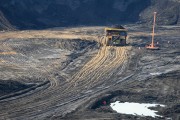I had a little bit of U.S.-envy as I read an article describing a delay by our neighbours to the south in leasing land for natural gas production while the greenhouse gas implications of the decision were considered. I was envious because Alberta doesn't follow any such process for oilsands development.
Lands here are leased with no environmental assessment or public input. And that's not working out so well for Albertans. Without any land-use planning, Alberta has leased out 84,000 square kilometres (an area the size of Scotland) to oilsands development. Trying to complete land-use planning after the fact is very challenging. Alberta’s tenure regime limits the government’s ability to effectively manage development because it is not informed by a land-use plan, it includes no credible environmental assessment and it provides no opportunity for public input or comment.

It’s been three years since we highlighted the need for input and review prior to leasing land in our report, Haste Makes Waste: The Need for a New Oilsands Tenure Regime. Unfortunately, the Government of Alberta has not responded.
We identified six key problems with Alberta’s oilsands tenure process:
- A narrow policy objective of maximizing oilsands development and revenue.
- The absence of environmental objectives or a land-use framework to guide tenure decisions.
- A failure to consider environmental impacts when granting oilsands rights.
- Inadequate opportunity for public input into decisions to grant oilsands rights.
- Lack of consideration of the public interest in decisions to grant oilsands rights.
- Incentives and requirements that increase development pressure in the absence of cumulative environmental assessment.
Alberta is giving away rights to the land without questioning what’s going to happen with it.
Compare this to the case I read about this week where oil and gas lease sales covering 370 square kilometres in Montana, North Dakota and South Dakota — scheduled for April 13 — were delayed pending environmental reviews on possible greenhouse gas emissions.
The U.S. actually requires many steps of environmental review before granting a lease. The U.S. Bureau of Land Management, one of the organizations responsible for granting lease applications, is mandated to follow a review process outlined in the National Environmental Policy Act (NEPA). That means that decisions on lease sales are made with a better understanding of environmental implications.
While the U.S. approaches its decision to grant oil and gas leases in an informed manner, here in Alberta we’re walking in with our eyes wide shut. It’s the root of many of the current problems in the oilsands.









